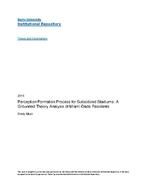|
|

Notes
- Abstract:
- For over a century, municipalities throughout the United States have contributed public subsidies to professional sports franchises for stadium and arena construction. These subsidies have been the center of many debates focusing on whether it is appropriate and legal for public monies to be used for private enterprises. However, several courts throughout the United States have determined that professional sports stadiums and arenas provide a ‘paramount public purpose’. This designation legally allows many municipalities to provide subsidies, even if the public has not voted, or even previously voted against it. Research has shown these subsidized facilities do not provide any economic benefit to the surrounding area. Due to the threat of relocation from the teams, municipalities often reluctantly offer subsidies citing that the teams provide intangible benefits like civic pride. The proclamation that teams provide these intangible benefits has been upheld in the legislatures statement of what constitutes ‘paramount public purpose’ and has been reflected in a myriad of recent subsidy campaigns. While these benefits are difficult to quantify, they have been a driving force for providing subsidies. As, stadiums incorporate advanced technologies and luxurious amenities the cost to the municipalities is growing exponentially. Under the pretense of serving a ‘paramount public purpose’ major league franchises have received over $17 billion of public money for facilities with an additional $4 billion cost for forgone federal taxes from 1992-2012. Accordingly, this research investigated the perceptions of Miami-Dade residents with regard to Miami Marlins Park, a $2.4 billion stadium that was 70% subsidized by the taxpayers without a vote and amidst public outcry. Additionally, the terms of the financing provide a very favorable lease and revenue agreement to the team. Therefore, the research sought to determine what outcomes residents associated with the stadium and team and if the project indeed serves a ‘paramount public purpose’ as perceived by the residents. In-depth and informal interviews of residents, unobtrusive analysis of media reports, and observations in and around the stadium provided data that revealed the process that residents experience as they form their perceptions and the various outcomes and influences that impact their overall perception of the facility.
- Thesis:
- Thesis (Ph.D.)--Barry University, 2015.
- Bibliography:
- Includes bibliographical references (leaves 220-245).
Record Information
- Source Institution:
- Barry University
- Holding Location:
- Barry University Archives and Special Collections
- Rights Management:
- Copyright Emily Must. Permission granted to Barry University to digitize, archive and distribute this item for non-profit research and educational purposes. Any reuse of this item in excess of fair use or other copyright exemptions requires permission of the copyright holder.
- Resource Identifier:
- GV416.F56 M87 2015_MustEmily ( BU-Local )
- Classification:
- GV416.F56 M87 2015 ( lcc )
|
|